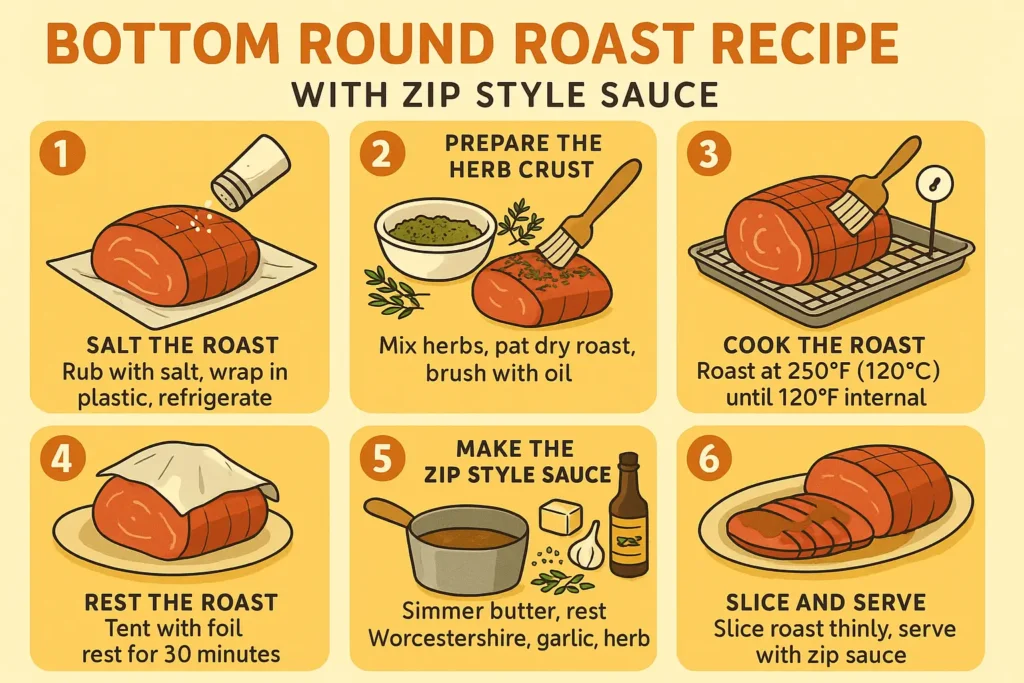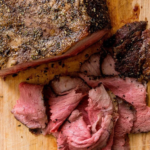Bottom Round Roast Recipe with Zip Style Sauce

The best way to make a bottom round roast recipe successful is by using low and slow cooking techniques that preserve tenderness and boost flavor. When people search for a bottom round roast recipe, they often want more than just a list of ingredients and steps. They want a meal that turns out juicy, flavorful, and worth the wait.
The bottom round cut comes from the hindquarters of a cow, making it lean, affordable, and ideal for slow-cooking methods. While it can become tough if not cooked correctly, the right techniques will turn it into a hearty and satisfying dish.
From oven roasting to next-day leftovers, this article covers every aspect of bottom round roast so you can make the most of this underrated cut.
What Is a Bottom Round Roast?
Bottom round roast comes from the rear leg of the cow. It is lean, affordable, and large enough to serve a family or prepare meals for several days. Because it is low in marbling, it does not get tender on its own. It needs the right cooking approach to keep from becoming dry or chewy.
This cut is often used for:
- Slow roasting in the oven
- Pot roasting with vegetables
- Thin slicing for sandwiches or beef jerky

Understanding the structure of this meat helps you choose the best method for cooking and serving it. Its low fat content also makes it a good choice for people who are reducing saturated fat intake while still enjoying red meat.
Best Cooking Methods for Bottom Round Roast
Oven Roasting
Oven roasting at a low temperature is one of the most common and effective ways to prepare bottom round roast. It allows the meat to cook evenly and break down tougher muscle fibers. Use a meat thermometer to reach an internal temperature of about 135 degrees Fahrenheit for medium-rare before resting.
Slow Cooker Method
The slow cooker method turns this lean cut into a tender dish by using moisture and time. Add broth, herbs, and vegetables to the slow cooker and set it on low for 8 to 10 hours. This method is perfect for busy days or meal prepping.
Sous Vide Cooking
Sous vide uses a water bath to maintain precise temperature control. Set the water bath to 130 to 135 degrees Fahrenheit, seal the roast in a vacuum bag, and cook it for 24 to 30 hours. The result is a perfectly cooked roast with uniform texture and flavor.
Air Fryer Roasting
For smaller roasts, air frying can provide a quick and flavorful option. Season the meat well and cook at 360 degrees Fahrenheit for about 40 minutes, flipping halfway. Use a thermometer to avoid overcooking.
Bottom Round Roast Recipe with Zip Style Sauce
Equipment
- Oven
- Wire rack
- Rimmed baking sheet
- Temperature probe or meat thermometer
- Small saucepan
- Mixing bowls
- Sharp knife
Ingredients
For the Roast:
- 1 bottom round roast
- 2 teaspoons kosher salt (for salting)
- 2 teaspoons vegetable oil (for brushing)
- 1 teaspoon fresh thyme, chopped
- 1 tablespoon fresh rosemary, chopped
- 2 teaspoon black pepper
- 1 teaspoon kosher salt (for herb mixture)
For the Zip Style Sauce:
- 1 stick of butter
- 1/2 cup Worcestershire sauce
- 2 garlic cloves, minced
- 2 teaspoons rosemary, finely minced
- 1 teaspoon fresh thyme, minced
- 1/2 teaspoon kosher salt
- 1/2 teaspoon black pepper
Instructions
- Salt the Roast: Rub the roast evenly with 2 teaspoons of kosher salt. Wrap tightly in plastic wrap and refrigerate for at least 1 hour, ideally overnight to allow the salt to penetrate.
- Prepare the Herb Crust: In a bowl, mix thyme, rosemary, black pepper, and the remaining 1 teaspoon of kosher salt. Pat the roast dry with paper towels. Brush all over with vegetable oil, then apply the herb mixture evenly.
- Cook the Roast: Place the roast on a wire rack set inside a rimmed baking sheet. Insert a meat thermometer into the thickest part. Roast in a preheated oven at 250°F (120°C) until the internal temperature hits 120°F (about 2 hours). Turn the oven off and let the roast coast to 135°F for medium doneness without opening the oven door.
- Rest the Roast: Remove the roast and tent it loosely with foil. Let rest for 30 minutes to allow juices to redistribute.
- Make the Zip Style Sauce: In a saucepan over medium heat, melt the butter. Stir in Worcestershire sauce, minced garlic, rosemary, thyme, salt, and pepper. Bring to a gentle simmer until fully combined and aromatic. Do not boil.
- Slice and Serve: Using a sharp knife, slice the roast paper-thin against the grain for maximum tenderness. Serve warm with zip sauce generously drizzled over the slices.
Notes
- The overnight salting is key to tenderizing this lean cut—don’t skip it if time allows.
- Use a thermometer to avoid overcooking; bottom round can dry out quickly.
- The zip style sauce adds a savory, buttery finish that elevates this roast to restaurant quality.
Flavor Additions That Enhance the Roast
Even though bottom round roast is lean, it can absorb flavors very well with a few added steps:
- Garlic and rosemary: Classic flavors that penetrate the meat during slow cooking
- Soy sauce and Worcestershire sauce: Help build umami and salt depth
- Onions and celery: Add a savory base when cooking in broth or in a Dutch oven
- Mustard crust: Creates a tangy outer layer when mixed with herbs and rubbed on the roast before roasting
Consider layering flavors by marinating overnight, using a dry rub, and then adding broth or vegetables during cooking.
Nutritional Benefits of Bottom Round Roast
Bottom round roast is high in protein and low in fat, which makes it a smart choice for balanced meals. A 3-ounce cooked portion has around:
- 25 grams of protein
- 170 calories
- 7 grams of fat
- 0 grams of carbs
It is also a good source of zinc, iron, and B vitamins. When served with vegetables and whole grains, it becomes a well-rounded meal suitable for many diets.
Preparation Tips for Better Flavor and Texture
Marinating
Marinate the roast overnight to add moisture and flavor. A mix of oil, vinegar, garlic, and herbs works well. Marinades help break down tough fibers and enhance the final taste.
Searing
Before slow roasting or cooking in a slow cooker, sear the roast on all sides in a hot pan. This step locks in juices and creates a rich crust that adds depth to the dish.
Seasoning
Use salt, black pepper, garlic powder, onion powder, and rosemary for classic seasoning. Rubbing these spices into the meat a few hours before cooking enhances flavor.
How to Slice Bottom Round Roast for Best Results
Always slice the roast against the grain. This shortens the muscle fibers and keeps each bite tender. Use a sharp slicing knife and aim for thin, even cuts. If serving hot, slice just before serving. If using it cold, chill the roast before slicing for cleaner cuts.

Serving Suggestions
Pair your bottom round roast with sides that match its rich flavor. Here are some great choices:
- Mashed or roasted potatoes
- Glazed carrots or green beans
- Yorkshire pudding or dinner rolls
- Horseradish sauce or gravy
For sandwiches, add slices of roast to crusty bread with arugula and mustard or aioli.
How to Keep the Roast Juicy
Keeping a bottom round roast juicy is about managing time and temperature:
- Cook low and slow to give muscle fibers time to break down
- Use a thermometer to monitor internal temperature closely
- Let the roast rest for at least 15 minutes after cooking so juices settle back into the meat
- Keep it covered with foil while resting to retain heat without steam
Moist cooking methods, like slow cooking and braising, help the roast stay juicy by adding extra moisture throughout the process.
Common Mistakes to Avoid
- Overcooking: Lean cuts dry out quickly, so monitor temperature closely.
- Skipping the resting period: Let the roast rest for 10 to 15 minutes after cooking to keep juices inside.
- Not searing: Searing improves flavor and helps create texture.
Avoiding these mistakes will help ensure your roast comes out tender and tasty every time.
Conclusion
Cooking a perfect bottom round roast beef recipe is all about choosing the right method, seasoning well, and paying attention to temperature and slicing. Whether you roast in the oven, use a slow cooker, or try sous vide, each technique brings out different qualities in this lean cut.
Preparation steps like marinating, searing, and resting make a big difference in taste and tenderness. And with proper storage and slicing, your roast can stretch into several satisfying meals.
Now that you know how to handle this cut, try different methods to find your favorite. Whether serving a holiday crowd or planning weekday lunches, bottom round roast delivers value and flavor with every bite. Keep these tips in mind, and your roast will turn out great every time.
FAQs
What is the best way to cook a bottom round roast so it stays tender?
The best way to keep a bottom round roast tender is to cook it slowly at a low temperature. Oven roasting, slow cooking, or sous vide are ideal. Always let the roast rest after cooking and slice it against the grain to maintain tenderness.
Is bottom round roast good for roasting?
Yes, bottom round roast is well-suited for oven roasting when done at a low temperature. Since the cut is lean, it is important to sear it first and cook it slowly to avoid drying it out.
Can I cook bottom round roast in an air fryer?
Yes, smaller cuts of bottom round roast can be cooked in an air fryer. Set the air fryer to 360 degrees Fahrenheit and cook for about 35 to 45 minutes, flipping halfway. Use a thermometer to avoid overcooking.
Why is my bottom round roast tough?
Toughness usually comes from overcooking or slicing with the grain. To avoid this, cook the roast slowly and slice it thinly against the grain. Using a marinade or cooking in broth can also help break down muscle fibers.
es, you can freeze cooked bottom round roast. Let it cool completely, then wrap it tightly in foil or place it in a freezer-safe bag. It will keep well for up to 3 months. Thaw in the fridge before reheating gently in the oven or on the stove.
What are some good side dishes for bottom round roast?
Popular side dishes include mashed potatoes, roasted vegetables, green beans, and rice pilaf. Gravy or horseradish sauce also pairs well with the flavor of bottom round roast.
Is bottom round roast the same as rump roast?
No, bottom round roast and rump roast come from different parts of the cow. Bottom round is slightly leaner and located just below the rump. Both can be cooked similarly, but bottom round is better for slicing thin due to its firmer texture.
Can I use bottom round roast for sandwiches?
Yes, bottom round roast is excellent for sandwiches when sliced thin. Chill the roast before slicing to get clean, even slices. Pair it with bread, mustard, cheese, and greens for a hearty meal.







